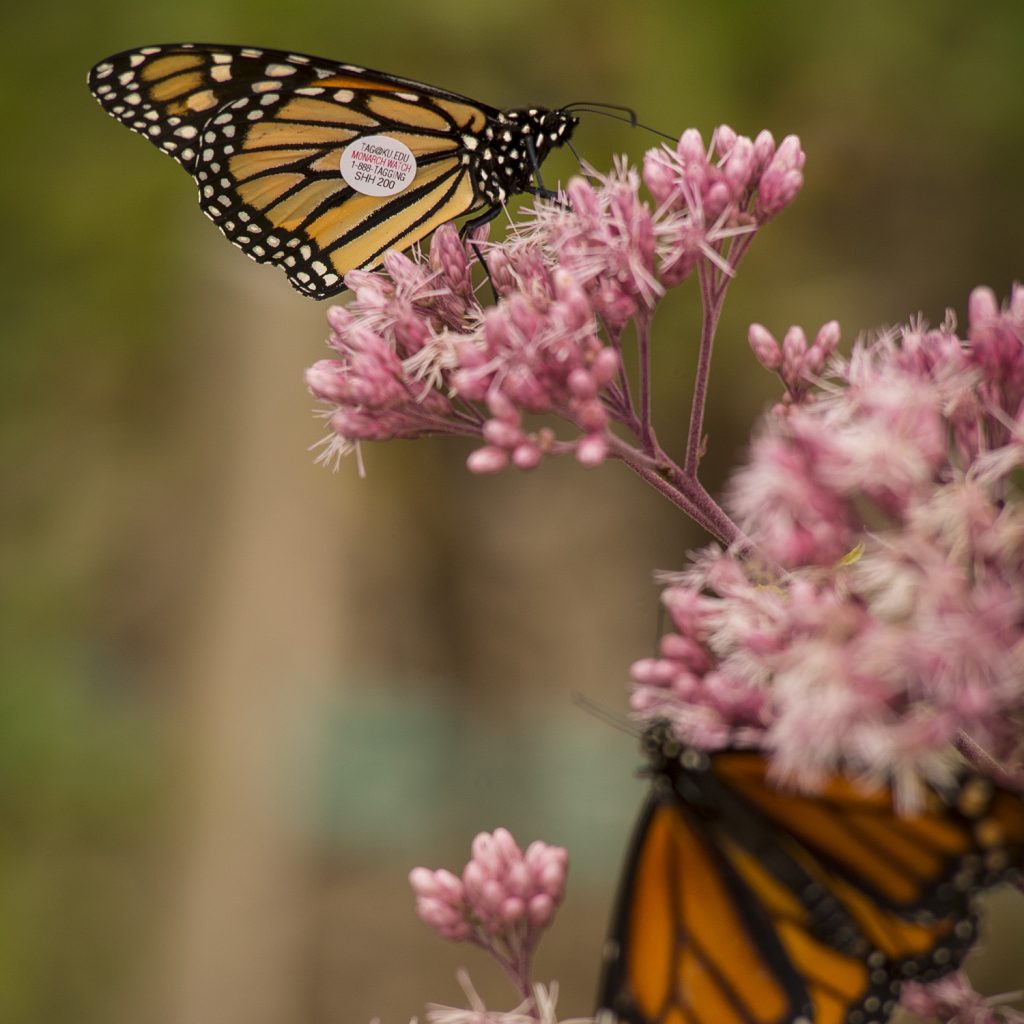All About Monarchs
Learn more about monarch butterflies and how you can help them along on their journey.
A monarch’s life is a story of enormous transformation. They start as an egg, and within a few days they emerge as a ravenous caterpillar. After 10-14 days of munching on milkweed leaves, the monarch forms a chrysalis. Over the next two weeks it undergoes a radical reorganization of its tissues, ultimately tearing free from its confinement as an adult monarch butterfly. If it hatched in the summer, it may live for another 2-5 weeks. In early fall, the final generation of monarchs has a special job: to migrate. This special generation may live up to 8 months.
Butterfly Garden Walk with Chip Taylor
Take a short walk into a butterfly garden with Chip Taylor, the founder of Monarch Watch, and see how simple it is to create a butterfly haven.
A Scientist's New Method
Tagging a fluttering insect that weighs only a few grams can be pretty difficult. That was one of the challenges that Fred and Norah Urquhart had to overcome in their journey to track monarchs.
After spending years trying to figure out a way to successfully tag monarch butterflies – a tedious process because their wings are very delicate and moisture-sensitive – Fred and Norah finally had a breakthrough in 1940. Thanks to a recent innovation that created the sticky material we now use on post-it notes, they created a tag with a similar material that managed to stick. Once they began tagging huge scores of monarchs the two soon realized they were going to need some help.
Fred and Norah founded the very first Insect Migration Association, known today as Monarch Watch, enlisting multitudes of volunteer “citizen scientists” all across North America to tag hundreds of thousands of butterflies and track their migration routes. In 1975, this ultimately helped Dr. Urquhart find out that these monarchs migrated from Canada all the way to the forests of Central Mexico.
Click Here For Monarch WatchAfter spending years trying to figure out a way to successfully tag monarch butterflies – a tedious process because their wings are very delicate and moisture-sensitive – Fred and Norah finally had a breakthrough in 1940. Thanks to a recent innovation that created the sticky material we now use on post-it notes, they created a tag with a similar material that managed to stick. Once they began tagging huge scores of monarchs the two soon realized they were going to need some help.
Fred and Norah founded the very first Insect Migration Association, known today as Monarch Watch, enlisting multitudes of volunteer “citizen scientists” all across North America to tag hundreds of thousands of butterflies and track their migration routes. In 1975, this ultimately helped Dr. Urquhart find out that these monarchs migrated from Canada all the way to the forests of Central Mexico.
The Monarch Migration
Widely recognized as the world’s foremost expert on monarch butterflies, Professor Lincoln Brower of Sweet Briar College came to The Wild Center in August of 2016 to talk about the monarch migration.
The event was made possible by the generous support of AdkAction.org and by Wild Center supporters.
The event was made possible by the generous support of AdkAction.org and by Wild Center supporters.
A Truly Marvelous Migration
Tagging a fluttering insect that weighs only a few grams can be pretty difficult. That was one of the challenges that Fred and Norah Urquhart had to overcome in their journey to track monarchs.
After spending years trying to figure out a way to successfully tag monarch butterflies – a tedious process because their wings are very delicate and moisture-sensitive – Fred and Norah finally had a breakthrough in 1940. Thanks to a recent innovation that created the sticky material we now use on post-it notes, they created a tag with a similar material that managed to stick. Once they began tagging huge scores of monarchs the two soon realized they were going to need some help.
Fred and Norah founded the very first Insect Migration Association, known today as Monarch Watch, enlisting multitudes of volunteer “citizen scientists” all across North America to tag hundreds of thousands of butterflies and track their migration routes. In 1975, this ultimately helped Dr. Urquhart find out that these monarchs migrated from Canada all the way to the forests of Central Mexico.
After spending years trying to figure out a way to successfully tag monarch butterflies – a tedious process because their wings are very delicate and moisture-sensitive – Fred and Norah finally had a breakthrough in 1940. Thanks to a recent innovation that created the sticky material we now use on post-it notes, they created a tag with a similar material that managed to stick. Once they began tagging huge scores of monarchs the two soon realized they were going to need some help.
Fred and Norah founded the very first Insect Migration Association, known today as Monarch Watch, enlisting multitudes of volunteer “citizen scientists” all across North America to tag hundreds of thousands of butterflies and track their migration routes. In 1975, this ultimately helped Dr. Urquhart find out that these monarchs migrated from Canada all the way to the forests of Central Mexico.
How to Grow Monarchs
Tagging a fluttering insect that weighs only a few grams can be pretty difficult. That was one of the challenges that Fred and Norah Urquhart had to overcome in their journey to track monarchs.
After spending years trying to figure out a way to successfully tag monarch butterflies – a tedious process because their wings are very delicate and moisture-sensitive – Fred and Norah finally had a breakthrough in 1940. Thanks to a recent innovation that created the sticky material we now use on post-it notes, they created a tag with a similar material that managed to stick. Once they began tagging huge scores of monarchs the two soon realized they were going to need some help.
Fred and Norah founded the very first Insect Migration Association, known today as Monarch Watch, enlisting multitudes of volunteer “citizen scientists” all across North America to tag hundreds of thousands of butterflies and track their migration routes. In 1975, this ultimately helped Dr. Urquhart find out that these monarchs migrated from Canada all the way to the forests of Central Mexico.
After spending years trying to figure out a way to successfully tag monarch butterflies – a tedious process because their wings are very delicate and moisture-sensitive – Fred and Norah finally had a breakthrough in 1940. Thanks to a recent innovation that created the sticky material we now use on post-it notes, they created a tag with a similar material that managed to stick. Once they began tagging huge scores of monarchs the two soon realized they were going to need some help.
Fred and Norah founded the very first Insect Migration Association, known today as Monarch Watch, enlisting multitudes of volunteer “citizen scientists” all across North America to tag hundreds of thousands of butterflies and track their migration routes. In 1975, this ultimately helped Dr. Urquhart find out that these monarchs migrated from Canada all the way to the forests of Central Mexico.

